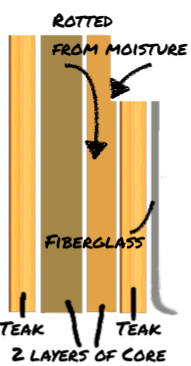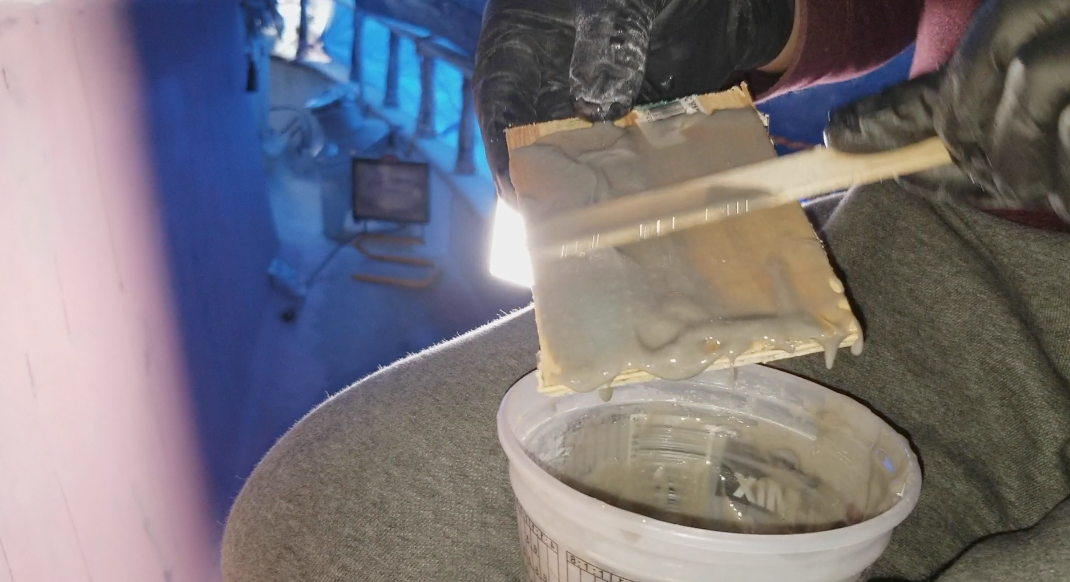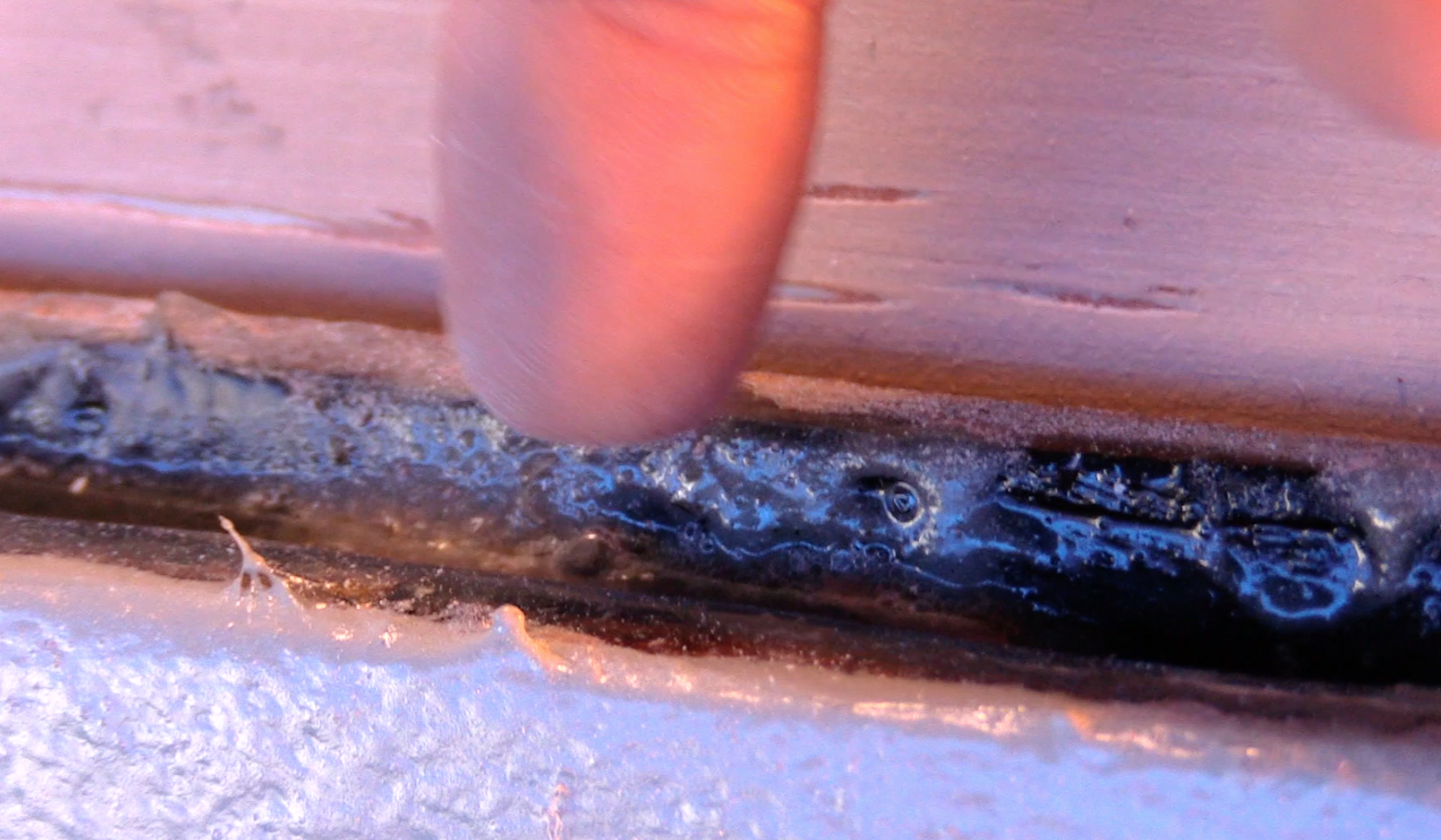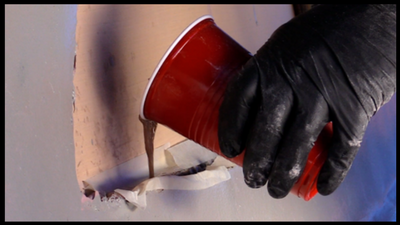 On DreamChaser while working to replace the fixed ports in the coach house, we ran into an issue with rot in the core. The coach house on a Formosa built in 1978 is a wooden structure formed on a fiberglass hull. It is two layers of plywood bonded together and “skinned” with long horizontal 1/2″ teak boards. The gray line in the diagram is where the new fiberglass layer we installed merges into the new fiberglass deck we had installed.
On DreamChaser while working to replace the fixed ports in the coach house, we ran into an issue with rot in the core. The coach house on a Formosa built in 1978 is a wooden structure formed on a fiberglass hull. It is two layers of plywood bonded together and “skinned” with long horizontal 1/2″ teak boards. The gray line in the diagram is where the new fiberglass layer we installed merges into the new fiberglass deck we had installed.
While these long teak boards allowed the boat to be beautiful with a classic teak look, it also was a source of weakness and vulnerability if not cared for properly. I suspect in our case that years of leaking ports allowed water to leak between the outer teak boards and get one of the plywood layers wet which led to rot in that layer.
We noticed that the glass in the forward port side was loose at times and had some vibration in it. When we removed the glass, this problem was not visible and made sense to address while doing the work. There were two options as we saw it. The first was to remove the outer layer of teak and cut or scrape off the rotted piece of plywood, epoxy new plywood to the existing one and put the outer teaks boards back in place. The second option was to repair the core rot in place. We chose the second option. to glass up over the outer teak adding additional strength and rigidity to the entire
We started with putting glass up over the outer teak boards to add extra strength and rigidity to the whole structure. This bonded it to the deck as a single unit rather than a wooden unit sitting on top of the deck. Once this was in place, we used scrapers and chisels to break up the 1/2″ plywood that was rotted. We also used a narrow shop vac attachment to suck the rotted and broken core up out of the opening on the bottom side of the port. When we inspected the center, we noticed that the plywood layers were intact on the sides and above the port and were only bad below it further reinforcing the entry point for water and the isolation of rot to the area below the ports. We also used a narrow shop vac attachment to suck the rotted and broken core up out of the opening on the bottom side of the port.
 When we inspected the core, we noticed that the plywood layers were fine on the sides and above the port and were only bad below it further reinforcing the entry point for water and the isolation of rot to the area below the ports. We cut small strips of new 1/2″ plywood to push down into the opening between the inner plywood and outer teak layers and cut them to fit just 1/2″ below the surface we would ultimately need for the lower lip of the port. We “buttered” each side of the pieces of wood with a thickened epoxy. We use West Epoxy due to its ease of use and how long it stores well on the boat with easy to use dispenser pumps.
When we inspected the core, we noticed that the plywood layers were fine on the sides and above the port and were only bad below it further reinforcing the entry point for water and the isolation of rot to the area below the ports. We cut small strips of new 1/2″ plywood to push down into the opening between the inner plywood and outer teak layers and cut them to fit just 1/2″ below the surface we would ultimately need for the lower lip of the port. We “buttered” each side of the pieces of wood with a thickened epoxy. We use West Epoxy due to its ease of use and how long it stores well on the boat with easy to use dispenser pumps.
 Once these were in place, we poured non-thickened epoxy over the vertical pieces and let it run down the void where the rotted core and new strips of plywood were. The goal was to fill the entire void from the deck surface up to the base of the port opening. In this photo, the epoxy has almost filled the void, and in the lower portion of the picture, you can see the top side of one of the small pieces of plywood that have been covered over with that layer of epoxy. I added more epoxy until the entire surface was full and smooth. The next step was to use the router to create the rabbeted edge that will accept the Glass. See a detailed post on How to prepare for the glass to be installed. A tip I learned after doing this a couple of times is to cover the outer and inner edges with masking or painters tape. Doing so will keep you drips from pouring of falling off the side of the pour cup onto a surface that you don’t want it to. Just remember to take the tap off while the epoxy is still wet otherwise you will have epoxy infused tape to sand off the surface. I learned that the hard way. 🙂
Once these were in place, we poured non-thickened epoxy over the vertical pieces and let it run down the void where the rotted core and new strips of plywood were. The goal was to fill the entire void from the deck surface up to the base of the port opening. In this photo, the epoxy has almost filled the void, and in the lower portion of the picture, you can see the top side of one of the small pieces of plywood that have been covered over with that layer of epoxy. I added more epoxy until the entire surface was full and smooth. The next step was to use the router to create the rabbeted edge that will accept the Glass. See a detailed post on How to prepare for the glass to be installed. A tip I learned after doing this a couple of times is to cover the outer and inner edges with masking or painters tape. Doing so will keep you drips from pouring of falling off the side of the pour cup onto a surface that you don’t want it to. Just remember to take the tap off while the epoxy is still wet otherwise you will have epoxy infused tape to sand off the surface. I learned that the hard way. 🙂

This is a closeup of the area between the outer fiberglass and inner plywood core. The opening is filled up with epoxy. Note the bubbles in the material, if this were a finish coat on top of a visible surface, I would have corrected this, but given this will be routed flat and smooth it is fine as is.

